Pepper is an important vegetable crop in Miami-Dade County, grown on about 2,000 acres each year and sold nationwide as a winter fresh market vegetable. Many pepper varieties are grown in this area, and the number is increasing due to market demand by increasing populations of diverse cultures, food habits, and traditions. In general, unlike other vegetable crops, peppers are relatively more adaptable to the environment, especially the heat, and are relatively easier to grow. More importantly, some chili peppers can grow through the hot and humid summer in Miami-Dade County, where summer is actually the fallow season for most vegetable crops. This is an advantage for local vegetable growers because only few vegetable crops, such as okra, yucca, malanga, sweetpotato, and some Asian vegetables including bitter melon, gourds, and luffa, can grow well during this time of the year. To be successful, careful attention must be paid to maintain healthy plants and high productivity with efficient management of soil and water for particular varieties or cultivars. This publication provides general information and guidelines for pepper growers in Miami-Dade County, including major pepper varieties, their horticultural traits, and fundamental soil and water management requirements. Therefore, the targeted audiences are vegetable growers, homeowners, Extension agents and specialists, consumers, industry and government employees.
Pepper Varieties, Origins and Their Horticultural Traits
Most pepper varieties, except sweet bell pepper and Cubanelle pepper, are used as an important ingredient or seasoning for food. The degree of pungency varies among varieties. To indicate how hot or pungent a pepper variety is, Wilbur Scoville (1912) invented a pungency scale to rank chili peppers from mild to hot, from zero to over 1,000,000 Scoville units based on the capsaicin concentration.
Peppers also are excellent sources of vitamin C and vitamin A due to the high concentration of carotenoids, such as beta-carotene, and provide powerful antioxidants that contribute to heart health. They also contain high concentrations of other important vitamins and minerals.
Chili pepper consumption is believed to dilate blood vessels and speed up metabolism because of the high concentration of capsaicin. In animal studies, capsaicin has the capability to boost metabolism, which in turn causes weight loss. This increases circulation and blood flow to all major organs, which facilitates oxygen and nutrient delivery. Chili peppers may support a healthy energy balance while suppressing appetite. Capsaicin has been shown to increase energy expenditure, act as metabolism booster and aid in long-term weight loss. Experimental results also show that the capsaicin treatment sustains fat oxidation during weight maintenance but does not affect weight regain after modest weight loss.
Below is a summary of pepper varieties most commonly grown in the Miami-Dade County area.
Bell Pepper
Bell pepper, Capsicum annuum, is a common type of pepper, grown commercially on raised beds with plastic mulch (Figure 1). The yield normally can reach over 1,000 cartons per acre (28 lb/carton). Fruits are green (Figure 2), and some cultivars can turn red (Figure 3), orange, or yellow in color at maturity. The hotness is zero Scoville unit. Cultivars, such as 'Hunter' and 'Red bull' have medium to large plants producing smooth, four-lobed, thick-walled, blocky, dark green glossy fruits. The produce is mainly used as an ingredient in fresh salad or sandwiches or as a cooked vegetable. A typical bell pepper can contain as much as 200 percent of the recommended daily allowance (RDA) of vitamin C, 17 percent vitamin B6, 14 percent vitamin K, 11 percent vitamin A, 11 percent folate, 9 percent manganese, 7 percent potassium, and 6 percent thiamin (dry-weight basis). There have been a number of cultivars developed in recent years with different yield potentials, physiological characteristics, and resistances to pepper viruses and other diseases.
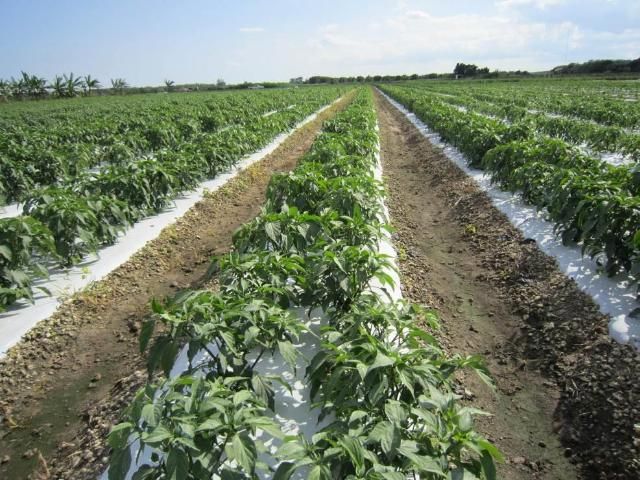
Credit: Qingren Wang, UF/IFAS
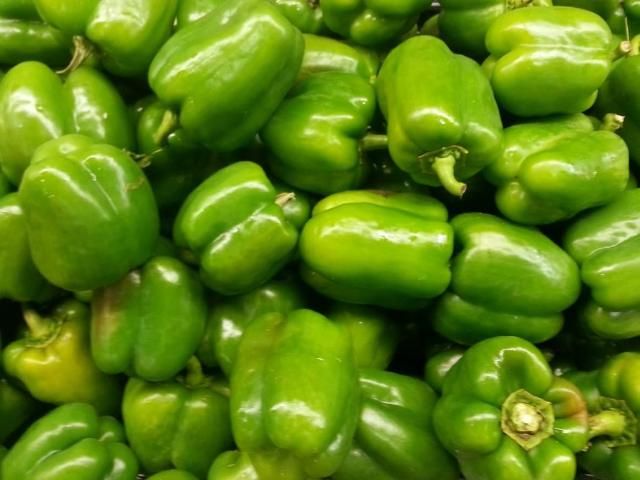
Credit: Qingren Wang, UF/IFAS
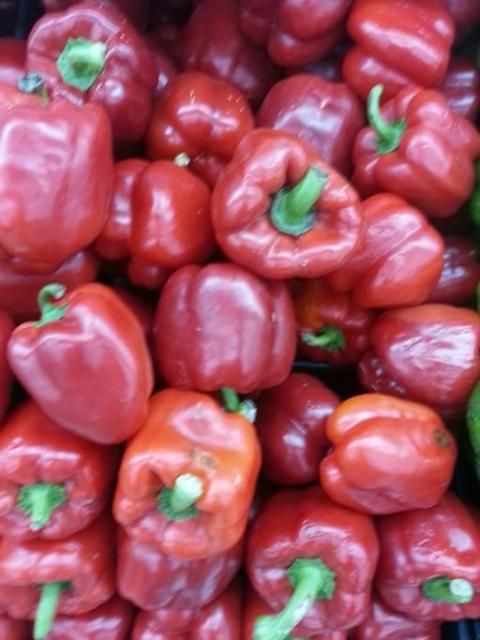
Credit: Qingren Wang, UF/IFAS
Cubanelle Pepper
Cubanelle pepper, also called Cuban pepper, is a variety of sweet pepper of the species C. annuum. Young fruit is light yellowish-green in color but turns bright red on ripening. Compared to bell pepper it has thinner flesh and is longer, with a slightly wrinkled appearance. It is extensively used in the cuisine of Cuba, the Dominican Republic, and Puerto Rico. It is also popular in dishes of Spanish, Italian, and Slavic origin, and many cooks prefer it to bell pepper types. Most Cubanelle peppers in the United States currently are imported from the Dominican Republic, where it is called ají cubanela. It has sweet, very mild flesh with a rich flavor and attractive color for frying and cooking. The heat level is about 1,000 Scoville units. Under the climate conditions in Miami-Dade County, Cubanelle peppers often grow in imperfect shapes and change color from green or yellow to shades of orange to red, and some fruits appear curled or twisted in shape (Figure 4).
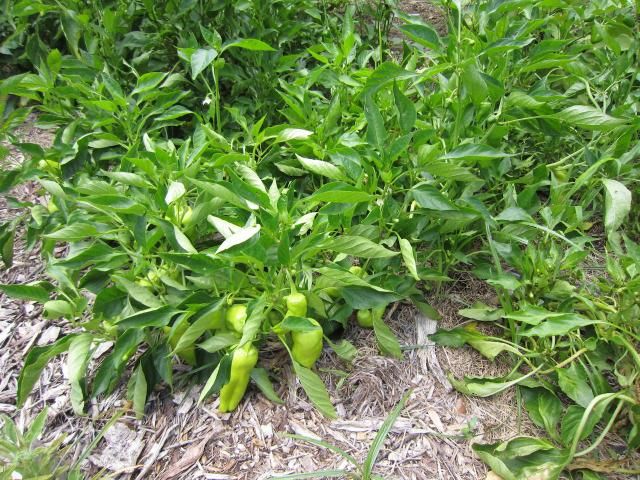
Credit: Qingren Wang, UF/IFAS
Jalapeño Pepper
Jalapeño (Figure 5) is one of the most common types of chili pepper grown in this area. Most people like it because it is spicy but not overwhelming. Jalapeños are green, turning red after maturity, and are about 2 to 3 inches long. The average pungency rates about 5,000 Scoville units and ranges from 2,000 to 8,000 Scoville units. Jalapeños are commonly used in fresh salad, salsa, and especially in Mexican food for a spicy flavor.
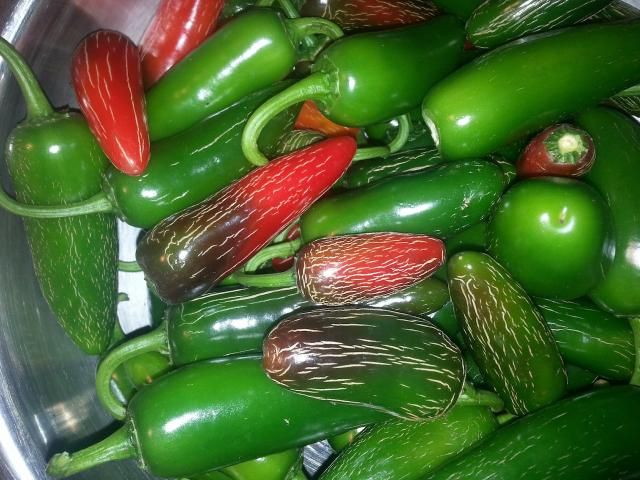
Credit: Qingren Wang, UF/IFAS
Habanero Pepper
Habanero pepper (Figure 6) is believed to originate from Peru but have spread through Mexico and other countries across the world. It derived from Capsicum chinense (Chinese pepper), mistakenly named because taxonomists in the 1800s mistook China for its place of origin. Today the largest production comes from Mexico's Yucatan Peninsula, where habanero is an ingredient in indigenous cuisine. The fruit ranges from 0.8–2.4 inches long; starts green; and matures yellow, orange, or red in color, but white, brown, and pink colors also occur. Habanero pepper has thin and waxy flesh. The pungency ranges 100,000–350,000 Scoville units. The habanero's heat; fruity, citrus-like flavor; and floral aroma have made it a popular ingredient in hot sauces and spicy foods. Habanero thrives in areas with hot weather such as Miami-Dade county and south Florida.
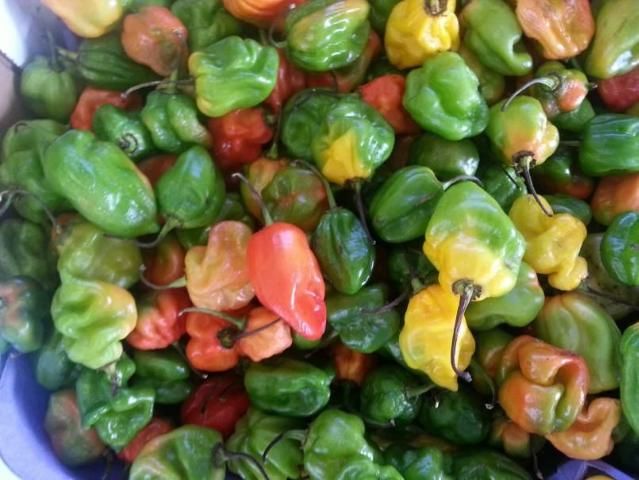
Credit: Qingren Wang, UF/IFAS
Cachucha Pepper
Cachucha pepper or Aji Dulce in Spanish is native to the Caribbean region. It has the appearance of habanero pepper with a spinning top shape and semi-wrinkled skin. This pepper has mild spice (500–1,500 Scoville units) with a sweet flavor. Cachucha peppers change in color from dark green to light green or yellow, then to orange-red when fully ripe (Figure 7). It is believed that cachucha peppers contain high amounts of vitamins C and B6. They are a good source of fiber, potassium, magnesium, and vitamin A. The acreage of Cachucha pepper is increasing rapidly in Miami-Dade County.
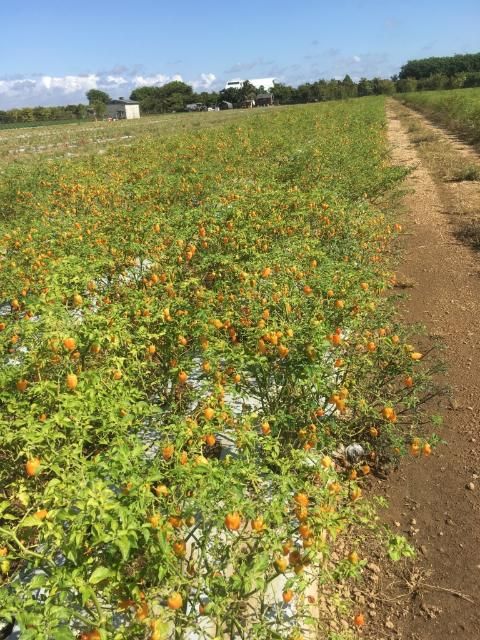
Credit: Qingren Wang, UF/IFAS
Scotch Bonnet Pepper
The Scotch bonnet chili pepper is a member of the Capsicum chinense species and a close relative of the habanero varieties. Its name derives from its resemblance to the Scottish tam o' shanter hat, though it appears primarily in the Caribbean, Guyana, and the Maldives. They usually mature to red or yellow and are very popular in cooking from the region, especially Caribbean jerk sauce and marinade. Scotch bonnet peppers have a thin, bright waxy flesh (Figure 8), similar to habaneros but slightly smaller, and score 100,000–350,000 Scoville units (PepperScale 2014). However, there are completely sweet varieties of Scotch bonnet grown on some of the Caribbean islands, and Scotch bonnet hot sauce is very popular.
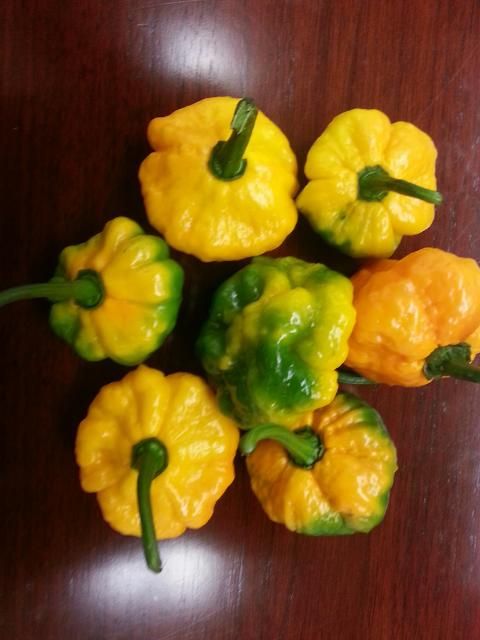
Credit: Qingren Wang, UF/IFAS
Poblano Pepper
Poblano pepper (Figure 9) is a popular Mexican chili pepper which can be consumed either unripe (green) or ripened (red). When ripened to red and dried, it traditionally is called "Ancho" (Kaiser and Erst, 2018). The thick-walled, mildly hot (1,000–2,000 Scoville units) fruit has a rich melon flavor. The name Poblano comes from the valley of Puebla, south of Mexico City, where it was popularly cultivated. This pepper can produce continuously through most of the summer, and matures in about 75–80 days. The fruit is about 4 inches long and 2 inches wide.
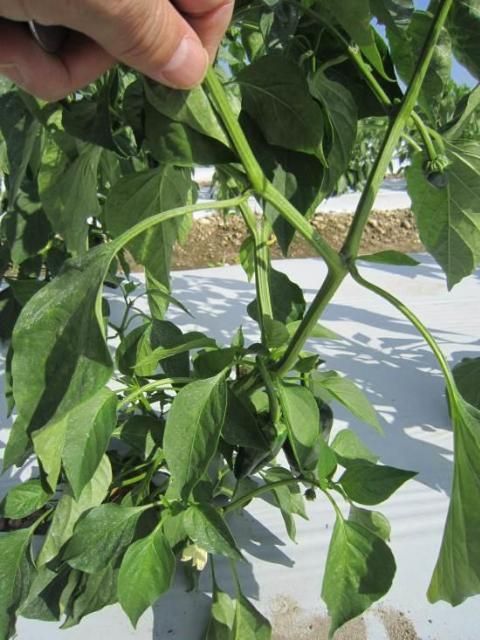
Credit: Qingren Wang, UF/IFAS
Anaheim Pepper
This type of pepper is usually maroon in color and has a long, skinny fruit (Figure 10). It is mild, usually about 1,000 Scoville units, although some varieties may be as hot as 5,000 Scoville units. It is a vigorous bushy plant with green fruit that turn deep red when ripe. The heirloom variety of Anaheim may have fruits as long as 7 inches, with a diameter of 1.5 inches. The fruit is often slightly tapered, and stem end is wrinkled or folded. It takes about 80 days to produce green mature fruit and more than 120 days for the fruit to ripen and turn red (Stephens 2012). Mature green or ripe red fruit can be used fresh or as dried powders.
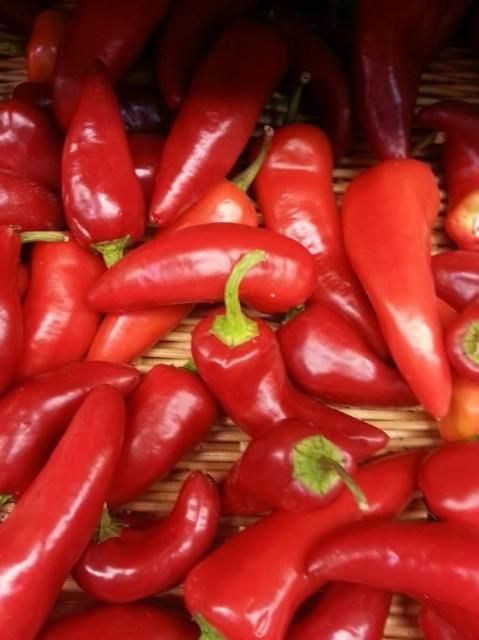
Credit: Qingren Wang, UF/IFAS
Serrano Pepper
The serrano pepper (Figure 11) is a type of chili pepper that originated in the mountainous regions of the Mexican states of Puebla and Hidalgo (DeWitt and Boslund 2009). The name of the pepper is a reference to the mountains of these regions. Serrano pepper is similar to jalapeño in appearance but is much hotter, ranging between 10,000 and 25,000 Scoville units. The fruit is usually about 2 inches long. The fruit can be harvested while they are unripe or ripe. Unripe serrano peppers are green, but the color at maturity varies, with common colors being green, red, brown, orange, or yellow. Serrano peppers grow well in soils with a pH between 7.0 and 8.5 and in temperatures above 75°F but they cannot tolerate frost. They grow well in hot and humid climates. These features make serrano peppers an ideal pepper variety to cultivate in the Miami-Dade County area. The plants can be as tall as 5 feet. Serrano peppers typically are eaten raw and have a bright and biting flavor that is notably hotter than the jalapeño pepper. Serrano peppers also are commonly used in making pico de gallo and salsa, as the chili is particularly fleshy compared to others, making it ideal for such dishes.
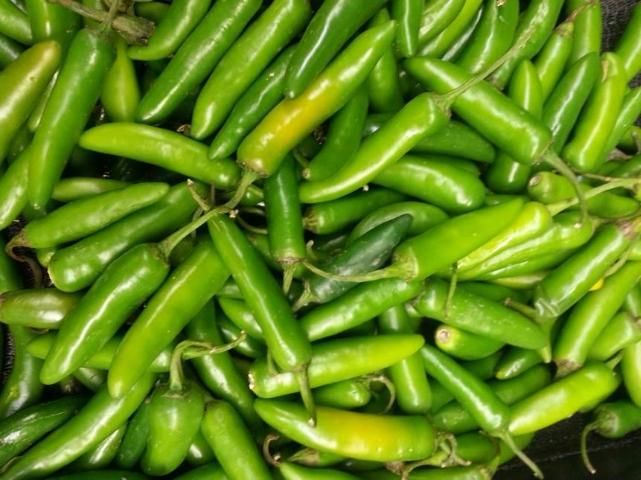
Credit: Qingren Wang, UF/IFAS
Cayenne Pepper
Cayenne pepper, named for the city of Cayenne in French Guiana, is also known as Guinea spice, cow-horn pepper, aleva, bird pepper, or, especially in powdered form, red pepper. It is a cultivar of Capsicum annuum related to bell peppers, jalapeños, paprika, and others. It is a hot chili pepper used to flavor dishes. The pungency is between 25,000 and 50,000 Scoville units. Red in color, the Cayenne pepper is generally dried and used as ground powder or dried flakes. The plants grow to 2–4 feet and can produce mature fruit in about 100 days after germination (Brown 2006). They adapt well to the hot and humid weather conditions in Miami-Dade County.
Tabasco Pepper
Tabasco pepper (Figure 12), named after the Mexican state of Tabasco, is a variety of the chili pepper species Capsicum frutescens. It is well known through its use in Tabasco sauce and peppered vinegar. The tabasco plant has a typical bushy growth, which commercial cultivation makes stronger by trimming the plants. It takes approximately 80 days after germination for the plants to have fully matured fruits. The plant can grow about 60 inches tall and develops quickly at temperatures between 80°F and 85°F, with cream or light yellow flowers that develop upward-oriented fruits. Tabasco fruits, like all other members of the C. frutescens species, remain upright when mature, rather than hanging down from their stems. The tapered fruits, around 1.5-inch long, are initially pale yellowish-green and turn yellow and orange before ripening to bright red. Tabascos range from 30,000 to 50,000 Scoville units of heat level (Harold 2004).
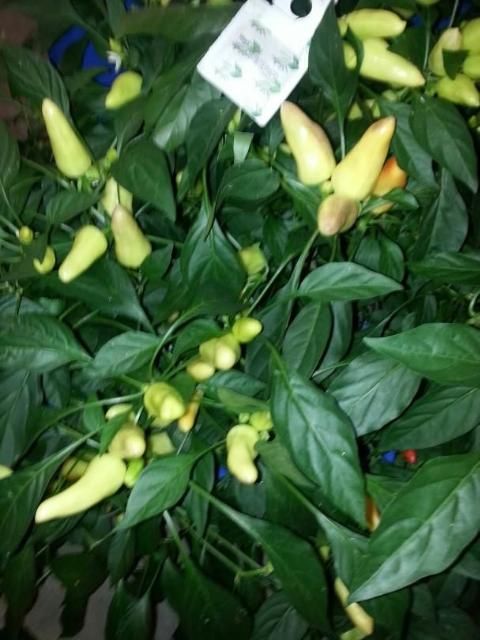
Credit: Qingren Wang, UF/IFAS
Thai Pepper
Thai pepper (Figure 13), also called bird's eye chili or bird's chili, is a cultivar derived from the species Capsicum annuum. The origin of Thai pepper might be from Mexico, Central America, or South America. Now it is very commonly grown in South or Southeast Asian countries, such as Thailand, Laos, Vietnam, Indonesia, and India. It is often confused with some cultivars derived from the species Capsicum frutescens because of the similarity in appearance. Thai pepper plant is a perennial with small, tapering fruits, often two or three at a node. The plant can grow up to 6 feet tall. The fruit is as small as about 1 inch long and less than 1/5 inch wide at shoulder. The heat index of Thai pepper ranges from 50,000–100,000 Scoville units.
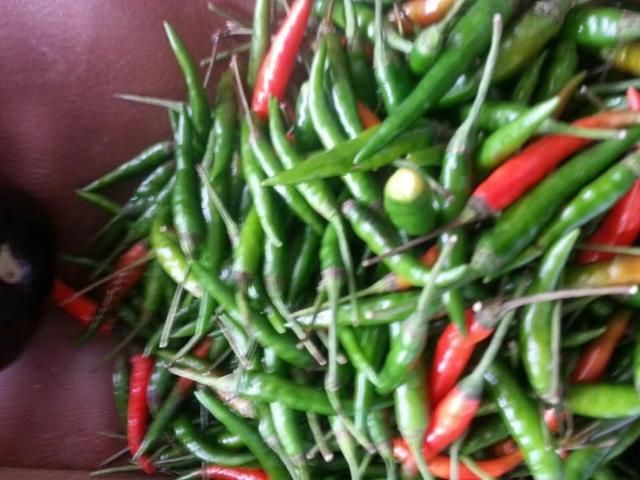
Credit: Qingren Wang, UF/IFAS
Hungarian Wax Pepper
Hungarian wax pepper originates from Hungary with wax-like texture of the pepper's rind in yellow color (Figure 14). This pepper looks quite like banana pepper but it is much hotter, which ranges 5,000–10,000 Scoville units as compared to only 0–500 Scoville units in banana pepper. Due to its bright yellow color, it is simply called hot wax pepper or hot yellow pepper. However, the yellow color turns to orange in hue and followed by red at full ripening.
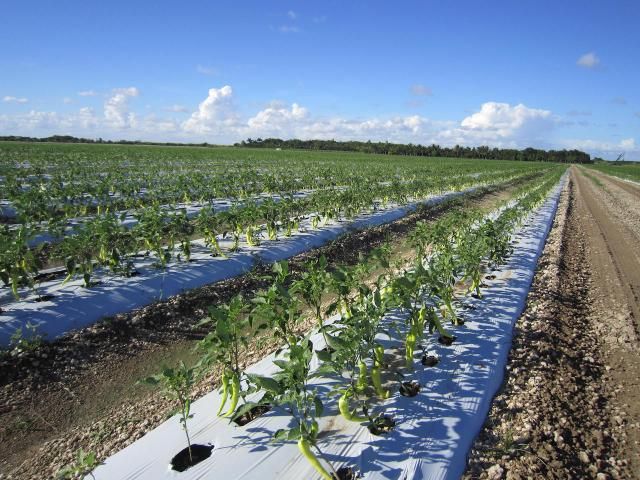
Credit: Qingren Wang, UF/IFAS
Bhut Jolokia
Bhut jolokia (Figure 15), known as naga jolokia, bih jolokia, ghost pepper, ghost chili pepper, red naga chili, and ghost chili, is an interspecific hybrid cultivated in the Indian state of Assam. The name "bhut jolokia" comes from the Bhutia tribe who used to bring it to the valley of Assam for trade. DNA tests showed that it is an interspecies hybrid, mostly C. chinense with C. frutescens. In 2007 Guinness World Records certified the ghost pepper as the world's hottest pepper, with 1,041,427 Scoville units, 401.5 times hotter than Tabasco sauce (2,500 to 5,000 Scoville units). It currently is ranked in third place following 'Carolina Reaper' (Guinness World Records 2013) and 'Trinidad Moruga scorpion', which are 2,009,000 and 2,200,000 Scoville units, respectively, but these peppers are rarely grown in the Miami-Dade County region. Ripe bhut jolokia peppers are approximately 2.4 to 3.3 inches long and 1.0 to 1.2 inches wide, with a red, yellow, orange, or chocolate color and very thin skin. The fruit can be rough, wrinkled, dented, or smooth. Bhut jolokia is widely used as an ingredient in spicy food and as a remedy for summer heat in some countries. It is used in both fresh and dried forms and has a unique flavor. In addition, the dried powder of such hot peppers can be developed into pepper spray as a self-defense product.
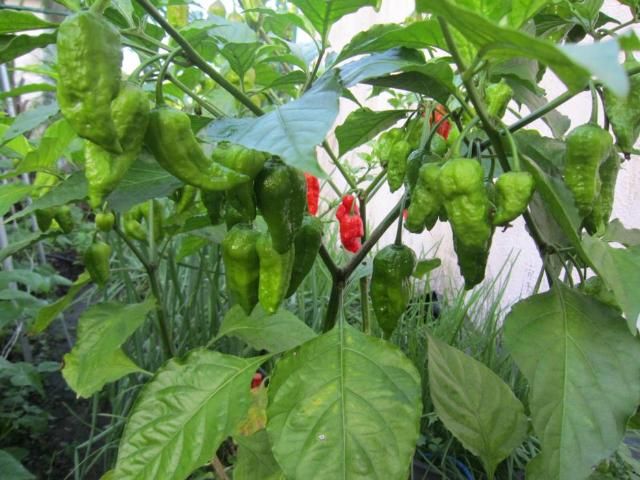
Credit: Qingren Wang, UF/IFAS
Soil, Land Preparation, and Transplanting
Soil and land preparation plays a critical role in pepper production in Miami-Dade County because most peppers are grown in Krome gravelly loam soil with low fertility but many rocks (>60 percent). In addition, the soil profile is as shallow as a few inches, and the aquifer is shallow (from 0 to more than 10 feet). The subtropical climate brings torrential rain during the hot summer, which often causes flooding and nutrient leaching from the soil, with drought during winter and spring seasons.
Peppers prefer to grow in fertile soils with appropriate moisture but they are sensitive to flooding. To improve pepper production, local growers usually grow them in raised beds approximately 3 feet wide and with 3 feet between beds, with plastic mulch and a drip irrigation system. Two rows of pepper are planted in each bed with planting distances of 6–18 inches depending on variety. For chili peppers, 2 or 3 transplants usually are placed in the same hole because of their small leaf area. For control of weeds and soil-borne pests including plant pathogens and insects, soil fumigation with metam sodium (Vapam®, Sectagon 42®) or metam potassium (K-pam®, Sectagon K54®) is recommended before cultivation, using appropriate application methods and following guidelines for worker protection. To allow sufficient time for the fumigant to dissipate completely, pepper seedlings should not be transplanted until 2–3 weeks after fumigating beds with sealed plastic mulch. The planting depth is about 1.5–2 inches.
Fertilization
The amount of fertilizers applied depends on soil fertility, which is determined through soil testing (Hochmuth, Mylavarapu, and Hanlon 2014). Pre-sampling and lab tests are useful to obtain a fertilization recommendation based on soil nutrient level (Freeman et al. 2014). Pepper varieties with various yields are additional factors to determine fertilizer rates to be applied. Best management practices (BMPs) are a guideline to follow (Freeman et al. 2014; Liu et al. 2015). In most cases, 10-10-10 or 6-16-13 (N-P2O5-K2O) dry fertilizer commonly is incorporated into the soil before planting. During the fruiting stage, liquid fertilizer with a formula of 4-0-8 or 3-0-10 (N-P2O5-K2O) is fertigated (applied with irrigation water) in the raised beds. Controlled release fertilizer (CRF) is a good option which can be applied at a heavier rate and can stay in soil longer compared to conventional fertilizers. The application of CRF has become a nutrient management tool (Liu et al. 2014), which can save labor and farming operation costs, but the feasibility often causes some concern due to the current relatively higher price.
Soil condition is important for a good yield, and different varieties prefer different soil conditions. For example, habanero prefers a slightly acidic soil (about pH 6), which is an obstacle to growing this type of pepper in Miami-Dade County because calcareous soil with a high pH (about 7.8–8.2) is prevalent. Even jalapeño pepper plants sometimes show severe iron deficiency (Figure 16). Foliar spray of ferrous sulfate or EDDHA-chelated iron can correct the symptom of iron deficiency. Applying acidic fertilizers, such as gypsum, (NH4)2SO4, superphosphate, or K2SO4, can help growers improve the root zone environment for the acidic soil preferred varieties.
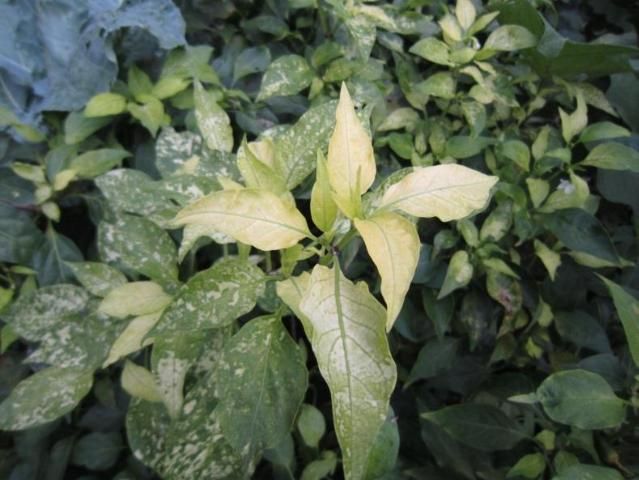
Credit: Qingren Wang, UF/IFAS
Irrigation and Freeze Protection
Drip irrigation systems (one drip line per bed) are commonly used for pepper production in the Miami-Dade County area. Irrigation frequency depends on plant growth stages, but twice a week usually is sufficient. However, for efficient water management pepper growers need to follow BMPs available from the county Extension services. As a general rule, good drainage is necessary for pepper plants because too much water not only will damage the plants but also can reduce the fruit flavor and appearance. A soil moisture monitoring device such as a tensiometer is recommended to be pre-installed in the pepper field; approximately 10–15 cbar can be a criterion to trigger the irrigation system.
Similar to other vegetable crops, pepper plants are susceptible to cold injury when the temperature drops 2°F below freezing (32°F). To protect pepper plants from cold damage, which most likely occurs between January and February, an overhead irrigation system usually is preinstalled to cover the pepper field. The pump should be kept on when the temperature drops close to the freezing point with low wind speed until the temperature rises again.
Conclusion
A large number of pepper varieties are grown in Miami-Dade County or south Florida because of the favorable weather conditions and the diverse populations with a demand for their traditional cultural recipes. To improve pepper yield and quality, appropriate management of soil nutrients, such as balancing macro- and micro-nutrients based on soil property and crop requirements, is essential. Controlling soil moisture by scheduling irrigation with a soil moisture system such as a tensiometer can improve water management efficiency and plant growth for promising yields and quality. For information about pest management of peppers, including diseases and insects, refer to Wang et al. (2015), Pest Management of Peppers in Miami-Dade County, Florida (http://www.edis.ifas.ufl.edu/pp316).
Reference
Andrews, Jean. 1998. "The Pepper Lady's Pocket Pepper Primer." University of Texas Press.
Boyd, N.S., E. J. McAvoy, C. F. Miller, J. Desaeger, G. E. Vallad, and P. Williams. 2020. "Pepper Production." Vegetable Production Handbook of Florida 2020-2021, p. 253-286. Gainesville, FL: University of Florida Institute of Food and Agricultural Sciences.
Brown, Ellen. 2006. "Growing Cayenne." http://www.thriftyfun.com/tf73134236.tip.html.
DeWitt, Dave and Paul W. Boslund. 2009. The Complete Chile Pepper Book: A Gardener's Guide to Choosing, Growing, Preserving, and Cooking. Portland, OR: Timber Press.
Freeman, J. H., G. E. Vallad, G. Liu, E. H. Simonne, G. J. Hochmuth, M. D. Dukes, L. Zotarelli, J. W. Nolling, D. A. Botts, P. J. Dittmar, and S. A. Smith. 2014. "Vegetable Production in Florida." Vegetable Production Handbook of Florida 2014-2015, p. 1–6. Gainesville, FL: University of Florida Institute of Food and Agricultural Sciences.
Guinness World Records. 2013. "Hottest chili." http://www.guinnessworldrecords.com/world-records/1/hottest-chili.
Hochmuth, G., R. Mylavarapu, and E. Hanlon. 2014. Soil Testing for Plant-Available Nutrients—What Is It and Why Do We Use It? SL408. Gainesville, FL: University of Florida Institute of Food and Agricultural Sciences.
Kaiser, C. and M. Ernst. (2018). Hot Peppers and Specialty Sweet Peppers. CCD-CP-101. Lexington, KY: Center for Crop Diversification, University of Kentucky College of Agriculture, Food and Environment. http://www.uky.edu/ccd/sites/www.uky.edu.ccd/files/hotpeppers.pdf
Liu, G., E. H. Simonne, T. K. Morgan, and G. J. Hochmuth. 2015. Soil and Fertilizer Management for Vegetable Production in Florida. HS711. Gainesville, FL: University of Florida Institute of Food and Agricultural Sciences.
Liu, G., L. Zotarelli, Y. Li, D. Dinkins, Q. Wang, and M. Ozores-Hampton. 2014. Controlled-Release and Slow-Release Fertilizers as Nutrient Management Tools. HS1255. Gainesville, FL: University of Florida Institute of Food and Agricultural Sciences.
McGee, Harold. 2004. On Food and Cooking: The Science and Lore of the Kitchen. New York: Scribner.
Pepper Scale. 2014. "Scotch Bonnet Pepper: The Caribbean chili of choice." http://www.pepperscale.com/scotch-bonnet-pepper.
Scoville, Wilbur. 1912. "Note on Capsicum." The Journal of the American Pharmacists Association 1: 453–454.
Stephens, James M. 2012. "Pepper, Chili – Capsicum annuum L. and Capsicum frutescens L." HS645. Gainesville, FL: University of Florida Institute of Food and Agricultural Sciences. https://edis.ifas.ufl.edu/mv112.
Wang, Q., Zhang, S., Seal, D., and Olczyk, T. 2015. Pest management of peppers in Miami-Dade County, Florida. PP316. Gainesville, FL: University of Florida Institute of Food and Agricultural Sciences.